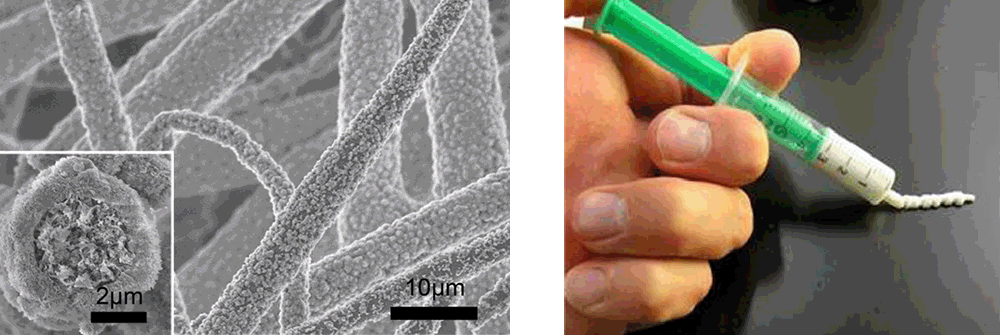15e In Vivo Evaluation of Amorphous Nano Tricalcium Phosphate in Flexible Composites and Injectable Bone Cements
The present contribution show two in vivo studies testing flexible bone implants for their advantageous clinical applications. We have prepared an open structured and highly porous network of amorphous calcium phosphate nanoparticles (ATCP) with biodegradable poly(lactide-co-glycolide) (PLGA) fibers [1]. In vitro bioactivity tests in simulated body fluid at 37 °C showed the deposition of a nano-sized hydroxyapatite layer on the fiber surface (Figure) within on single day. In vivo bioactivity tests were performed by creating circular defects in the cranium of rabbits and filled with cotton wool like PLGA/ATCP fibers. Another promising application for ATCP is the application as an injectable bone cement (Figure). A comparison to micron-sized α-TCP [2] showed that our amorphous TCP hardened within 7 – 15 minutes. Most promising results (resorption rate and new bone formation, histology, etc.) are given in an in vivo study in the femur of sheep.
Figure: Scanning electron microscopy images of cotton wool like appearance of TCP containing poly-(lactide-co-glycolide) fibers having a high in vitro bioactivity (left). Injectable bone cement consisting of amorphous TCP / α-TCP (right).
References
[1] O.D. Schneider, S. Loher, T.J. Brunner, L. Uebersax, M. Simonet, R.N. Grass, H.P. Merkle and W.J. Stark, J. Biomed Mater Res B, 2007, 84B(2), 350-62.
[2] T.J. Brunner, M. Bohner, C. Dora, C. Gerber, W.J. Stark, J. Biomed. Mater. Res., 2007, 83B(2), 400-7. 